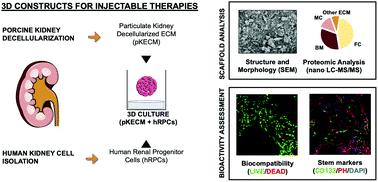当前位置:
X-MOL 学术
›
Biomater. Sci.
›
论文详情
Our official English website, www.x-mol.net, welcomes your feedback! (Note: you will need to create a separate account there.)
Particulate kidney extracellular matrix: bioactivity and proteomic analysis of a novel scaffold from porcine origin
Biomaterials Science ( IF 6.6 ) Pub Date : 2020-11-04 , DOI: 10.1039/d0bm01272f Rita Sobreiro-Almeida 1, 2, 3, 4, 5 , Maria Elena Melica 6, 7, 8, 9 , Laura Lasagni 6, 7, 8, 9 , Hugo Osório 10, 11, 12, 13, 14 , Paola Romagnani 6, 7, 8, 9, 15 , Nuno M. Neves 1, 2, 3, 4, 5
Biomaterials Science ( IF 6.6 ) Pub Date : 2020-11-04 , DOI: 10.1039/d0bm01272f Rita Sobreiro-Almeida 1, 2, 3, 4, 5 , Maria Elena Melica 6, 7, 8, 9 , Laura Lasagni 6, 7, 8, 9 , Hugo Osório 10, 11, 12, 13, 14 , Paola Romagnani 6, 7, 8, 9, 15 , Nuno M. Neves 1, 2, 3, 4, 5
Affiliation

|
Decellularized matrices are attractive substrates, being able to retain growth factors and proteins present in the native tissue. Several biomaterials can be produced by processing these matrices. However, new substrates capable of being injected that reverse local kidney injuries are currently scarce. Herein, we hypothesized that the decellularized particulate kidney porcine ECM (pKECM) could support renal progenitor cell cultures for posterior implantation. Briefly, kidneys are cut into pieces, decellularized by immersion on detergent solutions, lyophilized and reduced into particles. Then, ECM particles are analyzed for nuclear material remaining by DNA quantification and histological examination, molecular conformation by FITR and structural morphology by SEM. Protein extraction is also optimized for posterior identification and quantification by mass spectrometry. The results obtained confirm the collagenous structure and composition of the ECM, the effective removal of nucleic material and the preservation of ECM proteins with great similarity to human kidneys. Human renal progenitor cells (hRPCs) are seeded in different ratios with pKECM, on 3D suspensions. The conducted assays for cell viability, proliferation and distribution over 7 days of culture suggest that these matrices as biocompatible and bioactive substrates for hRPCs. Also, by analyzing CD133 expression, an optimal ratio for specific phenotypic expression is revealed, demonstrating the potential of these substrates to modulate cellular behavior. The initial hypothesis of developing and characterizing a particulate ECM biomaterial as a consistent substrate for 3D cultures is successfully validated. The findings in this manuscript suggest these particles as valuable tools for regenerative nephrology by minimizing surgeries and locally reversing small injuries which can lead to chronic renal disfunction.
中文翻译:

颗粒状肾细胞外基质:猪源性新型支架的生物活性和蛋白质组学分析
去细胞基质是有吸引力的底物,能够保留天然组织中存在的生长因子和蛋白质。通过处理这些基质可以生产几种生物材料。但是,目前尚缺乏能够逆转局部肾脏损伤的能够注射的新底物。在本文中,我们假设脱细胞的颗粒肾猪ECM(pKECM)可以支持肾脏祖细胞的后植入。简而言之,将肾脏切成小块,通过浸入去污剂溶液中去细胞,冻干并还原成颗粒。然后,通过DNA定量和组织学检查,ECFI的分子构象以及SEM的结构形态,分析ECM颗粒中残留的核材料。还对蛋白质提取进行了优化,以通过质谱进行后鉴定和定量。所获得的结果证实了ECM的胶原结构和组成,有效去除核酸物质以及与人肾脏非常相似的ECM蛋白的保存。将人肾祖细胞(hRPCs)与pKECM以不同比例接种在3D悬浮液上。在培养的7天中进行的细胞活力,增殖和分布的测定表明,这些基质是hRPC的生物相容性和生物活性底物。同样,通过分析CD133表达,揭示了特定表型表达的最佳比例,证明了这些底物调节细胞行为的潜力。已经成功验证了开发和表征颗粒状ECM生物材料作为3D培养的一致基质的最初假设。该手稿中的发现通过最小化手术和局部逆转可能导致慢性肾功能不全的小损伤,建议这些颗粒作为再生肾病学的宝贵工具。
更新日期:2020-11-12
中文翻译:

颗粒状肾细胞外基质:猪源性新型支架的生物活性和蛋白质组学分析
去细胞基质是有吸引力的底物,能够保留天然组织中存在的生长因子和蛋白质。通过处理这些基质可以生产几种生物材料。但是,目前尚缺乏能够逆转局部肾脏损伤的能够注射的新底物。在本文中,我们假设脱细胞的颗粒肾猪ECM(pKECM)可以支持肾脏祖细胞的后植入。简而言之,将肾脏切成小块,通过浸入去污剂溶液中去细胞,冻干并还原成颗粒。然后,通过DNA定量和组织学检查,ECFI的分子构象以及SEM的结构形态,分析ECM颗粒中残留的核材料。还对蛋白质提取进行了优化,以通过质谱进行后鉴定和定量。所获得的结果证实了ECM的胶原结构和组成,有效去除核酸物质以及与人肾脏非常相似的ECM蛋白的保存。将人肾祖细胞(hRPCs)与pKECM以不同比例接种在3D悬浮液上。在培养的7天中进行的细胞活力,增殖和分布的测定表明,这些基质是hRPC的生物相容性和生物活性底物。同样,通过分析CD133表达,揭示了特定表型表达的最佳比例,证明了这些底物调节细胞行为的潜力。已经成功验证了开发和表征颗粒状ECM生物材料作为3D培养的一致基质的最初假设。该手稿中的发现通过最小化手术和局部逆转可能导致慢性肾功能不全的小损伤,建议这些颗粒作为再生肾病学的宝贵工具。


























 京公网安备 11010802027423号
京公网安备 11010802027423号